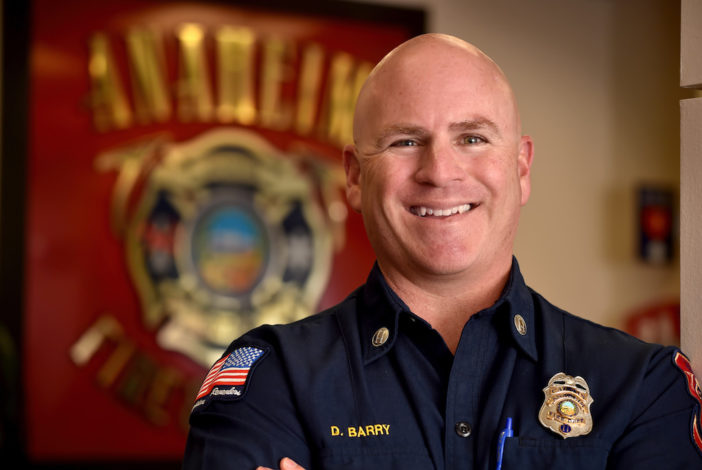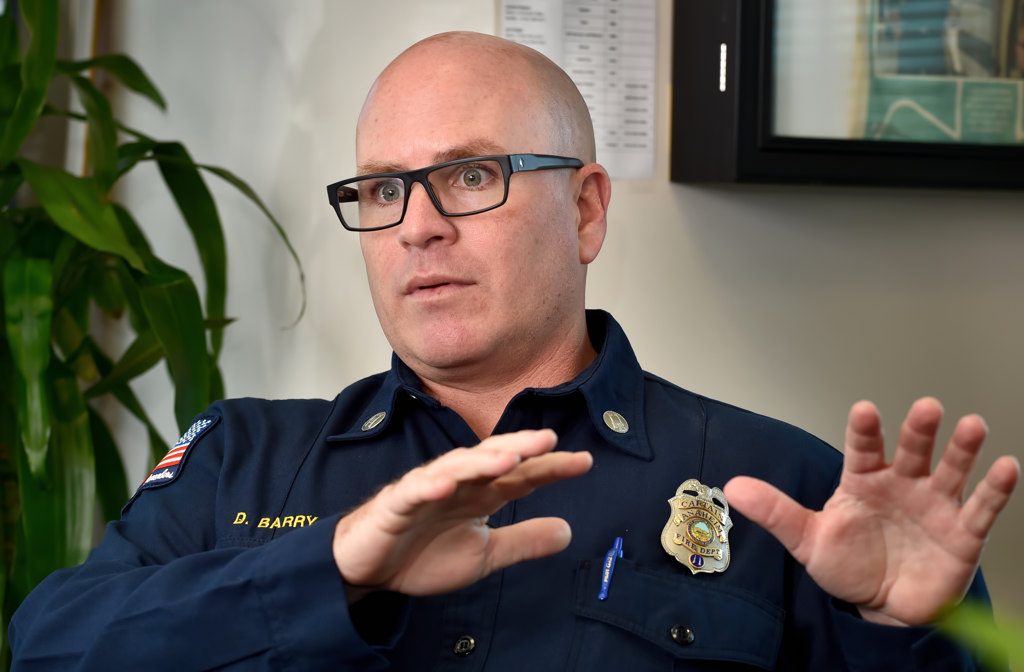The email signature of Anaheim Fire & Rescue Capt. Dave Barry reads:
Did you try and turn the iPad off and then on again?
It’s a sly reference to Barry’s role at the agency as the de facto IT guy — the man with the answers to all things Apple.
The advice in Barry’s email signature works more than half the time, he figures.
Within AF&R, Barry wears many hats.
Officially, he’s Emergency Medical Services captain and paramedic.
As the fire service agency’s EMS manager, he’s in charge of all AF&R paramedics and EMTs.
All firefighters in Orange County are EMTs. Becoming a paramedic requires six more months of training (and a significant amount of dedication).
Barry is responsible for making sure all of AF&R’s EMTs and paramedics are current on training and certification.
Barry also manages two nurse educators who work for AF&R on a contract basis, visiting stations to keep firefighters up to date on the latest medical-related developments.
Anaheim Fire & Rescue is unique in that about 65 percent of its nearly 200 firefighters — 130 — are paramedics. Unlike most other fire service agencies, AF&R firefighters maintain their paramedic status as they move up the ranks.
Because nearly 85 percent of the roughly 40,000 calls for service AF&R receives each year are for medical aid, the agency’s focus on Emergency Medical Services is a big benefit to residents and businesses in the city, as well as the millions of tourists who visit Anaheim every year.
“It’s a huge benefit to have a fire-based EMS system,” says Barry.
All of the responding units in the city fire engines and fire trucks are equipped with Advanced Life Support (ALS) supplies. The same units are capable of treating a heart attack patient, using the “Jaws of Life” to extricate a trapped victim, and fighting a structure fire.
And as AF&R firefighters advance throughout their careers, they retain a wealth of knowledge by keeping their paramedic skills sharp (they have to be recertified every two years).
“I’ve seen throughout my career every possible type of trauma,” Barry says, “and like most of our paramedics, I have that Rolodex in my head that I can go to when I’m out on calls.”
These days, as EMS captain, Barry isn’t in the field as often as he used to be (he is when he covers extra shifts on the weekends).
He now works 7 a.m. to 5 p.m. four days a week, a schedule that allows him to attend more family events than he was able to as a firefighter pulling 24-hour shifts, often several days in a row.
Barry has been a paramedic for 24 years. He served relatively brief stints in La Habra and Westminster before joining AF&R 22 years ago.
Barry, 46, was drawn to the field by a couple of friends who joined the fire service.
Initially, the graduate of Edison High School in Huntington Beach wanted to become a pilot in the military. But he didn’t have perfect vision (a requirement back then), so he started taking fire science classes and became an EMT.
Barry started as an EMT driving ambulances. He graduated from the Basic Fire Academy at Santa Ana College in 1993. After that, he enrolled in paramedic school at Daniel Freeman.
At Anaheim Fire & Rescue, Barry spent years in the field as a firefighter paramedic. He then became an engineer paramedic and, in 2012, he became a captain medic.
For years, Barry was involved in paramedic training with his EMS manager predecessors, who traditionally had been nurses at AF&R.
About 3½ years ago, when the previous EMS manager left, Pat Russell, the agency’s deputy chief of operations, asked Barry, then a captain at Station 11, if he could step into the position for a couple of months.
It made a lot of sense.
After all, a couple of years before Russell made that request, Barry implemented the rollout of iPads used in the field by firefighter paramedics to fill out Electronic Patient Care Reports (EPCR) while on calls — information that immediately is sent to the ambulance company and hospital.
Anaheim Fire & Rescue was among the first fire service agency to go electronic with patient care reports, equipping its 11 stations with iPads (hence Barry’s email signature — he’s the guy AF&R paramedics call when something isn’t working right on their iPads).
What was supposed to be a temporary gig for Barry as EMS manager turned into a full-time one. And he’s even getting more tech savvy. Sometime around July this year, he should earn a bachelor’s degree in Information Technology from Columbia Southern University.
“The chiefs really liked having a captain with field perspective in this position,” said Barry, who was quick to point out that he still consults with nurses when he needs their expertise.
For example, if a firefighter is exposed to a communicable disease, such as meningitis, Barry’s the one who handles the paperwork and talks to nurses and doctors at hospitals to make sure the firefighter gets proper treatment.
In addition, Anaheim Fire & Rescue recently purchased two drones the agency uses for training and educational purposes as well as on emergency incidents.
You guessed it: Barry’s in charge of the drones.
Oh, and he also manages Anaheim events that require the presence of two AF&R firefighter paramedics, such as Ducks and Angels games. Their job is to attend to players, coaches and referees (or umpires) should they require medical attention.
“If a player or coach is injured, the trainer will make eye contact with us and put a fist in the air, and we’ll come out with our equipment and the gurney,” Barry said.
Last year, AF&R paramedics had 220 deployments to those venues as well as the Anaheim Convention Center.
Barry also oversees AF&R’s innovative CCRU (Community Care Response Unit), a kind of urgent care on wheels designed to take the load off AF&R paramedics and reduce the number of transports to ERs.
“I love my job,” says Barry, who is married to a hairdresser and who has two teenagers.
His 16-year-old daughter is thinking of becoming a nurse, and his 15-year-old son is tossing around the idea of following his father into the fire service.
“It’s a great career,” Barry says with a smile.
 Behind the Badge
Behind the Badge




